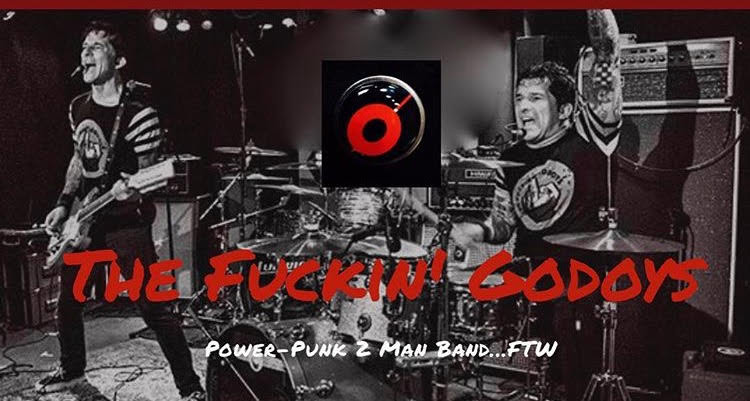The Fucking Godoys
Art and Steve’s influence on the skateboard community goes beyond explaining to the regular Joe. In fact, it goes beyond skateboarding and runs deeply into the art and tattooing communities and punk rock music being in a family tree of some of their influences like the MC5, Stooges, Chelsea, The Vibrators and Cock Sparrer. Their experiences in life and skateboarding paved the way for The Godoys to express themselves for who they are. And if you know Art and/or Steve, you know that they do not withhold their thoughts about anyone and anything. They are straightforward; they are blunt. You will hear a lot of “fucks” and “shit” and other words that virtuous ears will begin to bleed. But that is who they are; it is perfect, and nobody should give two fucks. That candidness feeds from their experiences.
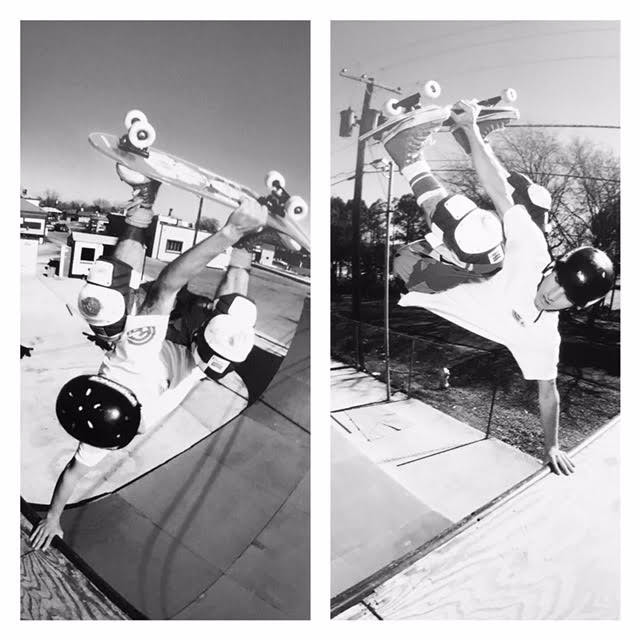
The Godoys connect more than twins. The connection they have is unlike any other twins. They work best “when together. It seems like we are one complete person.” There “is a certain sense of power that we have when we walk the streets together or play in a band together or show up at the skate park together.” There is a sense of confidence, power if you will, that shows in their creative work as well. The Godoys have always done their own thing and could give a fuck what people think. They rely on each other in ways similar to their early days in “survival mode” being homeless in Texas. They will never forget the cause.
The Beginning
My grandmother told me once that the best place to start is from the beginning. Steve and Art Godoy began their journey in the 1970s East Coast skate scene, but Steve will be the first one to tell you that skating on the East Coast was a drag. Nobody knew each other really. There were some places that had a small scene like Philadelphia and New Jersey (Cherry Hill). Steve and Art didn’t know the Jersey or Philly hometown heroes like Groholski and Victor Perez; they “were just kids, seeing these guys rip.” Already understanding that they were just a little different than all the “fucking squares” where they lived, they turned to half pipes and street riding banks and curbs when the weather permitted because they had no other choice. Trying to relate to those hicks who were chewing tobacco drove the two of them nuts. Skateboarding foreshadowed the conscious and sometime unconscious decisions to choose the path they wanted to choose. Steve admits that skateboarding was the savior from all the stupid shit that we, as skaters, could possibly have done. Like a lot of skaters, the ironic skateboarding life kept us out of trouble; but at the same time, fulfilled the adrenaline high we all search for.
The transiency life began in full force with the commitment to skateboarding. Their mom kicked them out of the house when they were in the 10th grade because they were tearing shit up. They were difficult to handle. Admittedly, they were just out of control. They never used drugs or alcohol; they were and still are straight-edge. They were just a “handful.” So they went to live with their dad in Mexico City.
This was a blessing in disguise. There, they continued to skate, getting more involved in the growing Mexican skate scene of the early 1980s. Mexico had a crazy skate scene back then; the Godoys embraced every part of it, even though the parks and terrain were not exactly “optimal.” They began skating a park named Skate-O-Rama designed by Peralta, Alva, and Waldo Autry. There, they skated “the Perfect Bowl,” but Steve contends that is was “far from perfect; it was a piece of shit but it had good vert.” They also skated Dogtown Skatepark’s “rad keyhole” during that time.
Mexico was pretty short lived, though. They were shipped back to Pennsylvania to live with their mom to finish up high school; they were kicked out again! Back to Mexico City; then; they hit Dallas, Texas and back to Pennsylvania, where they began doing some ‘home made tattoos’ on themselves using safety pins or exacto blades and black drawing ink for their tools.
They got sponsored in Dallas, just before they got back to Pennsylvania, by Zorlac because of their exploits in Texas skating The Blue Ramp and The Clown Ramp. Texas had the raddest “underground” vert scene. So many hard rippers were coming out of Texas at the time. Skaters like Craig Johnson, John Gibson, and Dan Wilkes. A memorable moment was at a contest and seeing Jeff Phillips “the best skater we [Art and Steve] had ever seen in our lives. We were like ‘Oh shit! This is real skateboarding!’” Using Phillips as a gauge knowing they were going to have to rip it up, Art got first in the non-sponsored am division, and Steve got 3rd. Zorlac sponsored Art, while through Jeff Newton (owner of Zorlac),Powell sponsored Steve. It was the first time the Godoys were on a different team. The awkwardness and the fact that Steve “didn’t feel [Powell] was punk enough ” ended that sponsorship; Steve left and went over to Zorlac.
Homeless
While they were living in Texas, they began to experience first-hand that it was the Godoys versus the world. Essentially, they were homeless and/or transient most of the time in Texas. They skated a lot, but getting a “real job” was the last thing they wanted to do. In reality, they did have jobs here and there. They silk screened for Zorlac, where the smell of the enamel was enough to fuck you up. It was here where tattooing began to become an outlet for their art. They continued doing homemade poke tattoos on their arms.
During that time, Zorlac discussed making a “shared” pro model for them. But rumors that Zorlac was about to take a shit put that in jeopardy. There was a bet that if Art got first place at the Shut Up and Skate Contest, they would get their pro model. “Art fuckin ripped!” He shredded using the Zorlac Big Boy Model, doing head high bonelesses on this 11 inch board. By some lame “politically biased judging, the ones who placed on top were Texans,” making it seem as though they wanted to keep the contest Texas: “Art got screwed by judges! I didn’t enter, I forget why I didn’t; regardless, for sure there was a feeling of judges ‘playing favorites’ in this contest,” Steve lamented assertively. After a bit, Zorlac was sold to a fish salesman. It was in debt so it was sold off. Since nothing came of promised “shared” model, they were sitting back thinking, “What now?”
So they went over to Kryptonics/Atlantic Skates and Tracker Trucks and toughed it out for a bit “It was a decent move which had some promise.” Again, it was too East Coast and the East was not getting the coverage in the mags that it could have; they needed to be on a company that was raw, more known and respected with a good team, magazine coverage, and an image and rep that coincided with their own. They stuck with Tracker for quite some time because they had a great team. Board sponsors matching their criteria were tough to find, though. The Godoys presented the idea of a shared, twin board to Skull Skates because it seemed raw and anybody who was a gnarly skater could get on Skull Skates; Skull had Duane Peters, Dave Hackett, Steve Olson and Christian Hosoi. That all sat well with Art and Steve. Skull Skates gave them their own model and they drew their own graphic, which was kind of scratchy, but that didn’t matter, it added the appeal Art and Steve wanted! So Skull put the scratchy graphics on their model and it sold pretty well.
Sadly what was/is common in skateboarding, the skaters that do not have a mind for contracts and rely strictly on word of mouth and confidence with dealing with any sponsors get screwed. “You gotta be on top of it, you gotta think business. We had some decent checks but not adequate for real survival,” Art states truthfully. In the end, shitty sales and rumors of fishy bookkeeping garnered them $17 or less per month: “When you are climbing, or trying to climb the ladder or attempting to mix-in to the market side of skating, you need a sponsor who knows how to push your image. Image sells. Your skating speaks for itself but an image that crosses into lifestyle sells. The company needs to know what it’s gonna take to make it so that their riders stay loyal and both benefit from sales and promotion.”
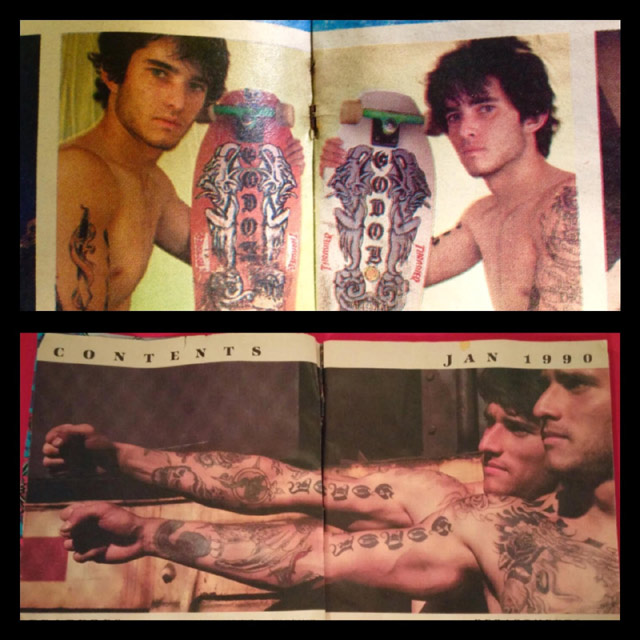
The Godoys, or anybody for that matter, could not live off $17 a month. So they had to resort to a different plan in true Godoy fashion. From time to time they had to resort to fucking chicks with money, chicks with wealthy parents, chicks who attended exclusive private schools, chicks that liked them for being “outlaw skaters” But the Godoys had no place to live at the time. Pretty much homeless unless “you accept that sleeping under the ramp or on it kinda makes it your home. We had no place to really take these chicks if we wanted to get a piece!” They had to break in to abandoned buildings or clubs in the winter to sleep or fuck them in their car, known as “The Pleasure Dungeon.”
Skull Skates had no interest in competitive skateboarding, which was a shame. “They were into skating for the sake of skating, which we understood. But we wanted to enter contests and make a mark because competitive skateboarding was where you needed to be if you were to be considered a pro skateboarder. The question was how we get in the magazines if we aren’t in the right place at the right time.” They made that shit up just so they could get whatever coverage possible. “There was a funny thing we did, we wrote a fake fan letter to TWS –We made it from a guy named John, It said something like: “My sisters are twins and they want to fuck the Godoys.” The title was “Dates For The Godoys,” just to get a little something printed in the magazine where our names were mentioned.” Bottom line, they were out growing Texas and needed to get to California.
Similar to Zorlac, Skull Skates was a dead end. So Art moved from Texas to California and with a suggestion from Jason Jesse; he had talks with T. Mag to be on a new company called H Street. Art goes to the Action Sports (ASR) in San Diego and gets his board released by H-Street, Tony Magnusson’s new company, plus $300 a month minimum. Meanwhile, Steve was struggling in Texas, hanging out with some crazy fuckers that could have got him in prison just by association.
San Diego
Art came to the rescue, bought Steve a plane ticket to California and told Steve about Bob Schmeltzer’s new company called Circle A, who was rumored to have some pretty cool, ripping, punk riders! So a deal was made and Steve was now riding for Circle A and feeling “at home.” The Godoys had always wanted to draw their own graphics, but Circle A had already commissioned their own in-house artist from their inception in order for the art, screen-printed t-shirts, and board images to stay uniform; so the company can have its own distinct style. Moving forward, on the ‘Circle-A business side of things,’ Bob Schmeltzer was losing confidence with the financial backer of Circle A and the walls were crumbling. Steve was kind of worried about where things were headed; finances were not as they should have been. The Godoys rode it out as long as they could, all the ups and downs. H Street was picking up steam; T. Mag was consistently placing top 5 in the pro vert contests H Street was planning on releasing many new pro models! Tony wanted the Godoys to draw the graphics for these boards and ‘just like that,’ a new side career was born. The word spread once the new H-Street boards were released with great success, prompting other pro riders to ask the Godoys to draw graphics for them. As a result, they did Danny Way’s first graphics, Steve Claar, Dave Crabb, Ken Fillion, Eddie Elguera, John Schultes, Tony Magnusson and so many more; of course, they drew their own.
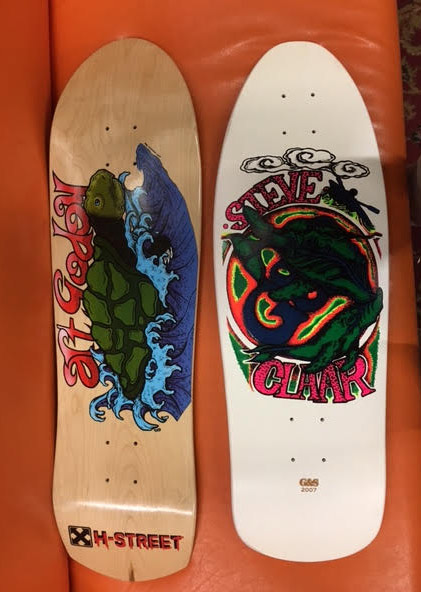
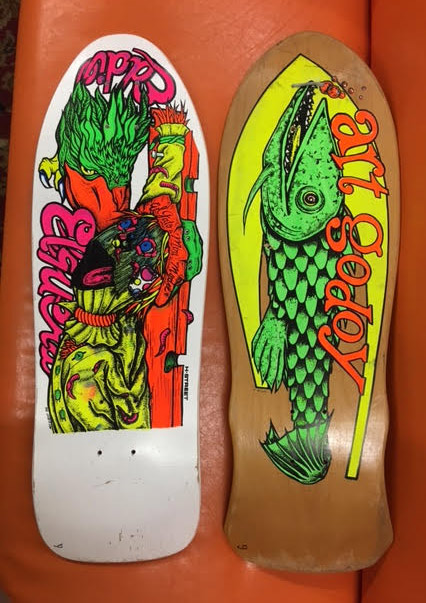
Drawing graphics or coming up with material for other people is sometimes a difficult thing, and the Godoys’ candidness and spontaneous creativity worked for their benefit. For example, with anybody who asked them for custom art, if they’re are not creative enough to think of something, the twins would throw something at them kind-a-like “pulling a rabbit out of a hat.” A random image or cluster of images, something fantasy…whatever popped into their head at the moment. “Most of the time we didn’t have to change the art nor the concept. It was free reign ALL THE WAY. We were charging $600 for black-line with color separations, like 4-10 colors sometimes.”
Some of the time, there is a little trickery in the artwork. “There were some symbolic images and little subtle secret hidden things, which always makes for interesting interpretations and raises curiosity of the beholder, but you know how it goes, sometimes people read too much into it… It’s always cool to hide secret shit in our artwork.” Like their first pro model for Skull Skates was from The Damned’s The Black Album. Steve continues, “Most of the time our graphics were random we just did whatever the fuck we wanted, something that nobody else had done because as far as themes go, it’s kind of about originality and style. I mean you could draw a pile of turds and depending on how your style is, it could be realistic or could be scribble. As long as it is well executed, someone’s gonna love it! Everyone has their own taste and the word ‘good,’ when it comes to describing any artwork, is very broad as well. In art, things like style and technique go a million different directions at one time; the same goes for artistic taste. We like to personalize our art, like I said, sometimes we would hide stuff or disguise images in our graphics, like our favorite bands logos and real fans would catch it, little things that might have meaning to us or to our ‘clients’ that nobody would catch, those were key things for us to include in the images, to personalize it.”
Tattoos
During this time—from 1983-1985—they were practicing tattooing on themselves, starting with super primitive safety pins and drawing ink hand pokes (as mentioned above) until finally moving up to using real electro-magnetic tattoo machines. They did a couple early practice ones on Jason Jesse. Everything they learned about tattooing technique is self-taught; they never served an apprenticeship because it was an impossibility due to the nature of the industry in the region where they got their start.
The evolution went from safety pins with black drawing ink to exacto blades with a little bit better ink to home-made machines with the typical prison set up: bent spoon, pen barrel, rubber eraser, bent and sharpened guitar string and rubber band, cleaning it in a bleach and water solution. “Kinda grosses us out to think about the health standards we didn’t follow from lack of education, but hell, we had to start someplace.” They got their first machine from a “sugar mom” of sorts who helped them out along the way: “A lot of shit was paid for, groceries, a car, [and] tattoo gear. It was totally like a television episode.” The gear was not top of the line, but they were stoked to have real gear and started practicing on themselves and friends. Soon they started tattooing at a motorcycle gang shop on weekends, “We were doing tons of art there, custom pieces, bits of flash as well, but mostly we drew out our own images for clients.” They hardly ever did wall flash; instead, whatever customers wanted they would draw it themselves, using at times, reference from books for added accuracy and detail. “It takes awhile to train your eye and to have your brain and hand remember technique and to recall programmed images to the point of being able to draw, let’s say a galloping horse without seeing any reference in front of you.”
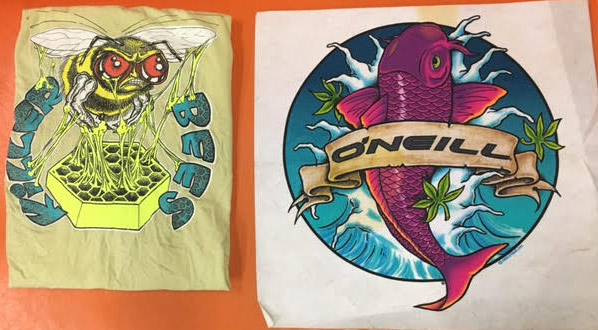
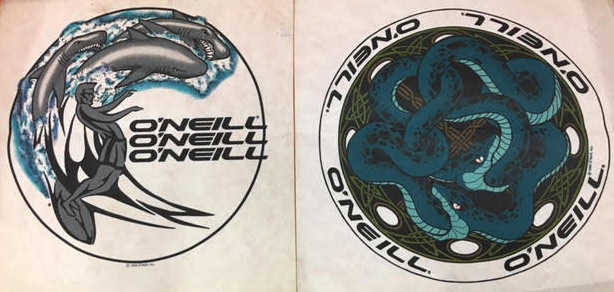
They kept their artistic skills flowing by doing commissioned work for O’Neil, Pirate Surf, and Quicksilver, Hobie Oceanside, Neal Morgan Surfboards, and Sony Music. They owned a silk screen shop and printed for Santa Monica Airlines and various bands including their own, in addition to airbrushing surfboards and silk screening. H Street financially backed their own skateboard company, Iron Cross Skateboards, which was named after lyrics from a Radio Birdman song: “Cross of Iron, spirit within remembers,” which again, as mentioned above in our previous art, went deeper that just images. The name of our skateboard company, although seemingly simple bears a hidden personal meaning to us.
This skateboard career upgrade was a great way for them to bow-out of skateboarding; they started to finally receive royalty checks that could actually support themselves and the company stayed afloat until the demise of vert skating: “unless you owned a ramp or could street skate competitively, you were pretty fucked and had to get a regular job, try to involve yourself in the industry as a sales rep or whatever or create your own type of business.”
But the question remained, why did they get into tattoos and tattooing, for that matter. The answer is a simple one: punk rock. “Tattooing and the tattooed biker lifestyle from those days had nothing to do with punk rock; it was in no way related. Tattooing was not in the hands of youth, and punk rock always has and always will depict angry and frustrated youth. We just so happened to be involved with both: we loved punk rock energy, creativity, and fashion; the feeling of being outsiders and happy to not care about what is ‘in’ and the rebellious, outlaw nature of it.” They continue, “We loved tattooing, the art, the idea of permanently marking yourself and being a walking statement that “we could give a fuck about anything the ‘normal’ society deemed a necessity or termed as proper behavior: like having an education based on lies, sports teams designed to bring the idea of ‘group efforts’ into your world by making you a ‘team player,’ acceptance of others’ short comings and participating conformity, listening to common shit, acting the same, etc. Being heavily tattooed in the 1980’s was NOT IN ANY WAY a status symbol; it was NOT ACCEPTED. It was threatening. It was HARD. It told others to fuck-off without us even having to say one fucking word. So there it is, simple math. Skateboarding was also something that was NOT IN THE SCOPE OF THE COMMON SMALL TOWN HICK.” The Godoys grew up on a diet of 1977 style punk rock, 1980s Oi! Bands, one of which fueled their fire: The Cockney Rejects.
The Cockney Rejects Rejects album, The Power and Glory played a particular importance: “we had Oi! Compilations that included these guys, singing about unity, a movement of skin heads and punks, running around causing shit, sticking together and not caring at all about the common conformists and cautious cowards. At this time, tattoos were also punk, just existing in another dimension, another ‘part of the world.’ Skateboarding had its day as an outlaw, individual based activity that was done alone or with the few friends or acquaintances from the neighborhood or at some skate park. It was existing alone on another planet with a few guys like Duane Peters flying the punk flag for kids who read the skate magazines to take note. None of these were deemed to be ‘alternative’ lifestyles. But on the same token, to us these were THE alternative lifestyle. ALTERNATIVE TO BEING A COMMON CLOWN.”
From what they saw, punk in the U.K. had been played out, became more fashion based. It was losing its power and standing. Its evolution turned into Oi! Music- described in some rock magazine-“Oi!, music to riot by!” The Godoys were still listening to The Clash , Sex Pistols and the bands from the era and got into bands like The 4 Skins, Cock Sparrer, etc. All the bands that were skins and punks, like Vice Squadce Squad, Infa-Riot and more. But the Rejects album (mentioned above) is where they got the idea to hand poke tattoos on themselves: “At the time we were kids. We couldn’t get into a shop to get a tattoo. We just went and did it on our own to the best of our knowledge,” laments Steve. They started poking and healing and poking and healing, covering as much of their human canvas as possible with the remedial tools and ability they had at the time. “The funny thing is, there is a sense of pride we have for the tattoos that were created with a safety pin and ink,” like Steve’s “Remember The Cause” that sits squarely on his left shoulder.
Hand poking these scribbly yet symbolic tattoos hold a certain value because it taught the Godoys about the use of “feel” and its importance in tattooing technique. It is a series of constant jabs that must be done without thinking about it: “You start knowing the feeling. You start feeling it in your fingers. This is how the Samoans and Pacific Islanders do it. They use actual thorns or bones or whatever can be made pointy enough to puncture flesh. So, you can feel it puncture, not just the surface layer, each layer of skin that you penetrate has its own click, feel, and sound. Then, you know you’re doing it right.”
Steve’s explanation brings him back to those days. His hands get into position as if he is holding a safety pin and he tilts his head a little to the right as if he is listening to the pin puncture the skin. His eyes widen and his voice rises a bit, “And you’re like, oh, I’m doing it right.” He mentions one has to listen for the second click. If the third is hit that is a little too deep and will hurt, but the second pop indicates that it is in the right spot. But it’s different with a tattoo machine because they rely on sound and feel and effect attained by the machines repeated movement of a kind of “brushing over the skin” with multiple needle groupings during the application process rather than feel of an individual pin penetrating into two layers of dermis per prick. The sound indicates the depth in hand poking a tattoo, so by watching the needle will let them know they are at the right depth. In other words, it’s ear-eye coordination.
The rad thing about tattoos, from an art perspective, is that there is a fluidity in what can be achieved by adding tattoos to tattoos; they can turn it all into one piece and not be like why this and why that. It can be a sleeve or leg piece or a small piece delegated to a specific part of the body: “you can put a fish next to a car, and frog with wings, anything you want and blend fantasy with realism with traditional style with black an grey and as long as it is well executed, just like in any art medium, then you got a winner. The difference is that tattooing is permanent. You get one chance as the artist to get it right.” This is what the Godoys love most about the art of tattooing. “The one chance to get it right,” the technique used to maneuver a group of needles on human skin using skin stretching, needle depth, repeated or steady cutting motions, diluted or opaque pigments—everything that goes into the application of a permanent piece of art that lives and dies with its wearer.
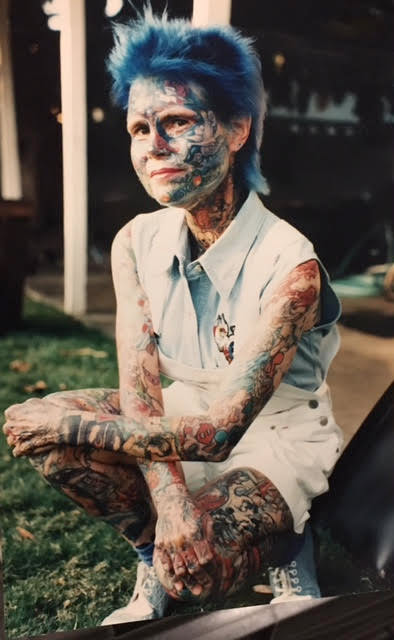
Although art and tattooing have different meanings to everyone, Steve and Art have a distinct perception on the influence art plays in their work. As far as what has had the most influence on their art, it’s really hard to say because all that stuff comes from somewhere. It’s hard to point the finger about the exact influences whether it be another artist, their creative minds, or just something visual; “Everything around you can be and artistic influence.” One thing is for sure, the Godoys definitely love realism. They never liked all that early, remedial “sailor shit.” When they got involved, there was a lot of “biker mentality mixed with a lot of Japanese influence,” establishing a kind of a foundation for their skateboard art and the different companies they drew for that wanted colorful bold logos. Their tattoo art, on the other hand, was influenced by pioneers of the single needle and black and grey style. Even though that was the influence, it goes without saying that the Godoys do tattoos their own way. “Tattooing realism for us came naturally from just wanting to replicate life’s images on the skin with exact micro detail.” Like skateboarding, the self-challenge is just a part of their life: “Like [when] you learn the front side grind, then you take it further but doing a standup grind across the whole top of the ramp then you do a 50/50. It’s just evolution.” They take it as far as they can, not having limits or “pigeonholing”; it’s about staying current, flexible, motivated, and driven.
Punk
Mentioning “what could be more punk than tattoos” gives “punk” an iconic definitive reference. At the same time, “punk” or being “punk” is different to a lot of people. To the Godoys, punk has had a significant part of their lives going back to East Coast 1973 (when they moved to PA from South America) until about 1984. The little town they lived in had very few people in the punk scene; in fact, the Godoys created the scene in their area with the few friends that were into it. Everyone in their community was listening to the same shit: Zeppelin, AC/DC, Boston, etc. They all smoked and drank; they were all just clones of each other. Hearing The Clash made them “shit themselves.” “It was exactly what we needed to perpetuate our cause. Punk to us was exactly what it’s meant to be. We didn’t take any shit. We did our own thing which we still do to this day.” Punk open a lot of doors. “It was as real as it gets. When we saw the Rejects with their tattoos, we figured that’s a great statement. It wasn’t shock value that we were striving for; it was ‘defining’ ourselves.”
The relationship between punk and art is a little more complicated. According to Steve, they are not the same creature. There is a difficulty in making the association that art has had the same influence on social movements as punk. Punk is a catalyst to rise-against for “social change” to “be a part of something or a one-man army just the same. As long as a cause is defined. There is an appreciation for Picasso and Michelangelo and their talent, but their art does not have the same strength to create a movement like Joe Strummer and The Clash did. That, to us, is a lot deeper of an influence in your whole being inside and out and it fuckin shows.”
As for The Fucking Godoys, “Art is such a music genius,” claims Steve. He is the music writer. Art writes the music and sends it to Steve with a pre recorded drum track from like garage band or “some shit like that” and tells Steve to make it work. Steve thinks of how he would play it and make it his own by altering the beat a little, “change it up a little.” Then, they get together to practice, figure out what songs they want to do, put together in a 14 song set or a 10 song album recording or even just one or two songs. All the while Art is in Vancouver, and Steve is in California. Before a tour, they practice the set list alone with headphones on; they meet the day before the show for a two-four hour rehearsal to “tighten up some shit.” And because they have been playing together since they were kids, “For us it’s easy shit.” The Fucking Godoys just got off tour recently with Radio Birdman. They played throughout Europe for 7 weeks.
Remember The Cause
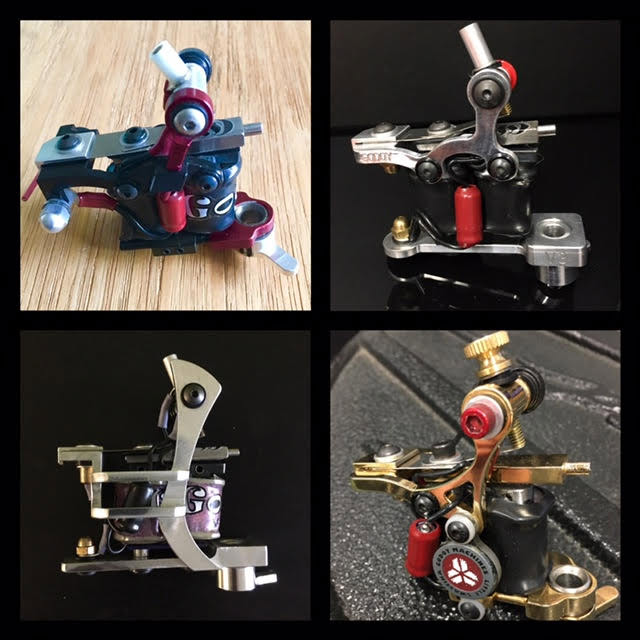
“One of the first homemade tattoos we did on ourselves was the statement, ‘Remember The Cause.’” At the age of 16, they were doing homemade tattoos on themselves and each other and liked what the statement encompassed. It refers to never losing sight of their goals, being true to themselves, what drove them, what molded them, and motivated them. “In general, to us, these ingredients molded and motivated us—skateboarding, tattoos, and punk rock— and from that we took full control; this statement ‘Remember the Cause’ more than anything [tells you to] stick to your guns, don’t take shit, respect yourself, lead the way, don’t follow, do what you say, be reliable, follow your own lead, set goals and achieve them, set higher goals and achieve them.” The Godoys have six patents (Godoy Machines). They have travelled all over the world time and time again for music, tattooing, and art. “Not many people can ride our fucking roller coaster or have ridden with us. We are non-asshole compliant, we are private people, and we live our life exactly how we want. FTW.”

